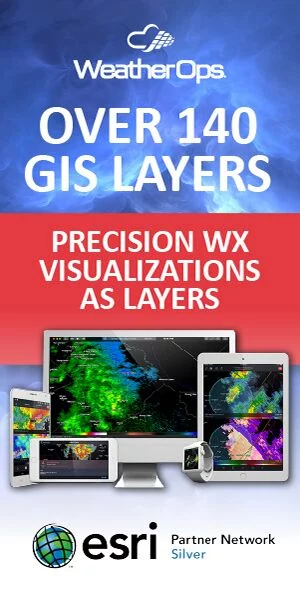Weather radars are complex scientific equipment subject to physical limitations. This section provides a little more information about how they work as well as resources for learning about them in more detail.
Beam Angle or Tilt
The radar beam is sent into the air at varying angles, or tilts, from the horizon. The lowest angle (tilt 1) is about 0.5 degrees for most radars. The highest angle (tilt 4) is between 3 and 4 degrees from horizontal. Higher tilts allow you to see higher levels of the storm structure. With any tilt, the farther the beam gets from the radar, the higher it is looking in the air. Because of the steeper angle, that effect is more pronounced in the higher tilts. The curvature of the Earth also comes into play, so even if there were no tilt to the radar beam whatsoever, it is looking higher above the ground the further it gets away from the radar.
Meteorologists use the higher tilts to get an idea of the vertical structure of a storm. But because of the steeper angle, those products can be a little more challenging to interpret. For most purposes, the casual user will want to stick with tilt 1, which is closest to the ground. But keep in mind, even the lowest tilt can be sampling at thousands of feet above the ground depending on the distance from the radar. There can still be a lot of weather happening in that lowest few thousand feet beneath the beam, even for the lowest tilt.
Update Frequency
Collecting radar data is not an instantaneous process for. It takes a certain amount of time to rotate the antenna and collect data for all the different tilts. Collectively these tilts make up what is called a volume scan. Depending on whether the radar is operating in clear air mode or precipitation mode, each volume scan takes a different amount of time. When running in precipitation mode, a volume scan takes 5-6 minutes. In severe weather mode, SAILS, MESO-SAILS, and AVSET can provide updates as quick as 72 seconds. In clear air mode, since the antenna is rotating more slowly, a volume scan takes about 10 minutes.
As a radar collects a volume scan, it first collects a 360-degree sample at an elevation angle of 0.5 degrees (tilt 1), then a scan for tilt 2, and so on, increasing elevation angle with each revolution. Once all the tilts for a given volume scan have been collected, it will recycle back down to tilt 1 and do it all over again. However, recent updates to the NEXRAD software insert an additional 0.5-degree scan in the approximate middle of the volume scan. This new scan strategy is called SAILS.
This process is why radar images update on a 2-10 minute interval. RadarScope is tuned to the NEXRAD volume scan strategy and only checks for new data at times defined by the current operating mode. Checking for updates more often than that is an unnecessary waste of resources because new data will not exist until the volume scan is complete.
Data Resolution
The resolution of NEXRAD Level II reflectivity data is 250 meters per pixel as you away from the radar along the beam, and an angle as the radar rotates. Other products may have higher or lower resolution. Like a flashlight beam, radar pulses widen as they get farther from the radar itself and the width of the pixels increases as a result. So the pulses become significantly wider and are thus lower resolution as you move away from the radar. RadarScope renders the data and displays images at the true resolution, so what you see is the most realistic representation of what the radar detected.
More Information
There’s a lot of useful information in radar images, but interpreting them can be a tricky prospect. It takes a good understanding of how the radar works as well as how the atmosphere behaves to make sound judgments during severe weather events. The NEXRAD network offers high-density coverage of the U.S., but it still can’t see everything. RadarScope is one of many tools you can use to stay informed. But it should always be used in conjunction with official information from the National Weather Service, local emergency management officials, and your local news media.
The U.S. National Weather Service has some good information on its web site about NEXRAD radar products. Here are a couple of pages that provide starting points for learning more about NEXRAD radar:
https://www.weather.gov/jetstream/doppler_intro
https://www.ncdc.noaa.gov/data-access/radar-data/nexrad






